The University Church in the city center was actually built by the Paulines – the only monastic order founded in Hungary – on the site of a mosque that survived from the Turkish era, on the corner of today's University Square and Papnövelde Street: they started the work in the early 1720s and it was structurally completed in 1742. The design was commissioned to András Mayerhoffer, one of the most significant architects of the 18th century, whose name is also associated with the Grassalkovich Castle in Gödöllő, for example. For the order, he created a church with two towers, the slightly undulating facade of which perfectly expresses the baroque style. He achieved this mainly with the accented wall pillars, which on the one hand strengthen the edges of the building, but also divide the main facade into three parts in the line of the towers.
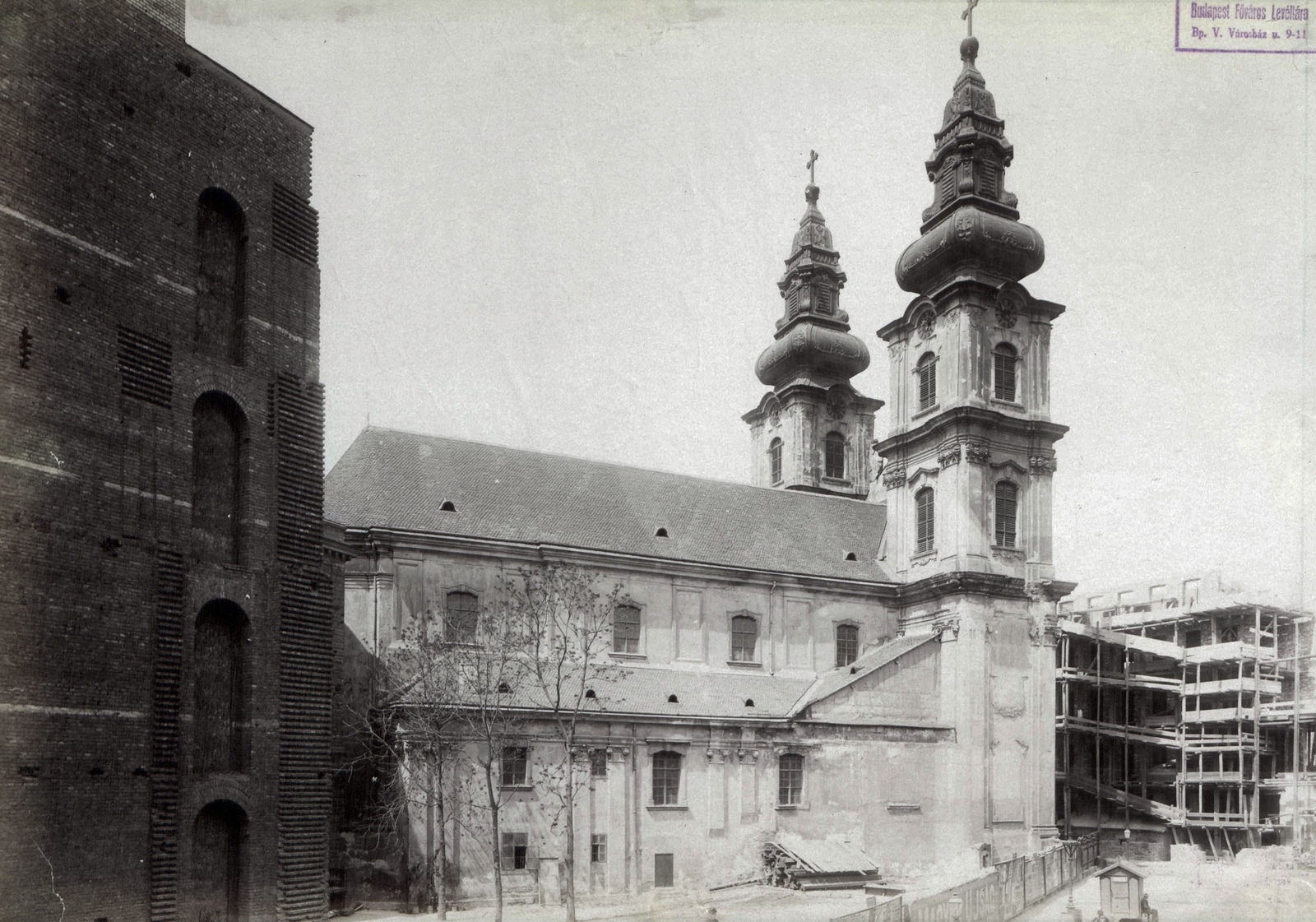
The University Church, photographed around 1894 from the side of today's University Square, at which time the central building of ELTE, in which the Faculty of State and Law also operates, had not yet been built (Source: Fortepan/Budapest Archives. Reference No.: HU.BFL.XV.19.d.1.07.076)
It is also divided vertically into three levels thanks to the fact that plastic ledges run along it, following the undulations. Between the towers, a triangular tympanum closes the facade, with the coat of arms of the order in it, to the left of it stands the statue of St. Paul the first Hermit, and to the right the statue of St. Anthony the Hermit. Although the order's rules require seclusion from the world, and their name was chosen after a hermit, the patron saint of this church is the Virgin Mary, the exact title of it is the Nativity of Mary. A statue of the Immaculate Conception, placed in a niche in the central axis of the facade, also refers to the Virgin Mary. The main entrance, richly articulated with columns and pillars and decorated with vases and puttos, also opens in the central axis. Here, even the double-winged wooden gate was covered with carvings.
 The baroque facade of the church today from Papnövelde Street (Photo: Péter Bodó/pestbuda.hu)
The baroque facade of the church today from Papnövelde Street (Photo: Péter Bodó/pestbuda.hu)
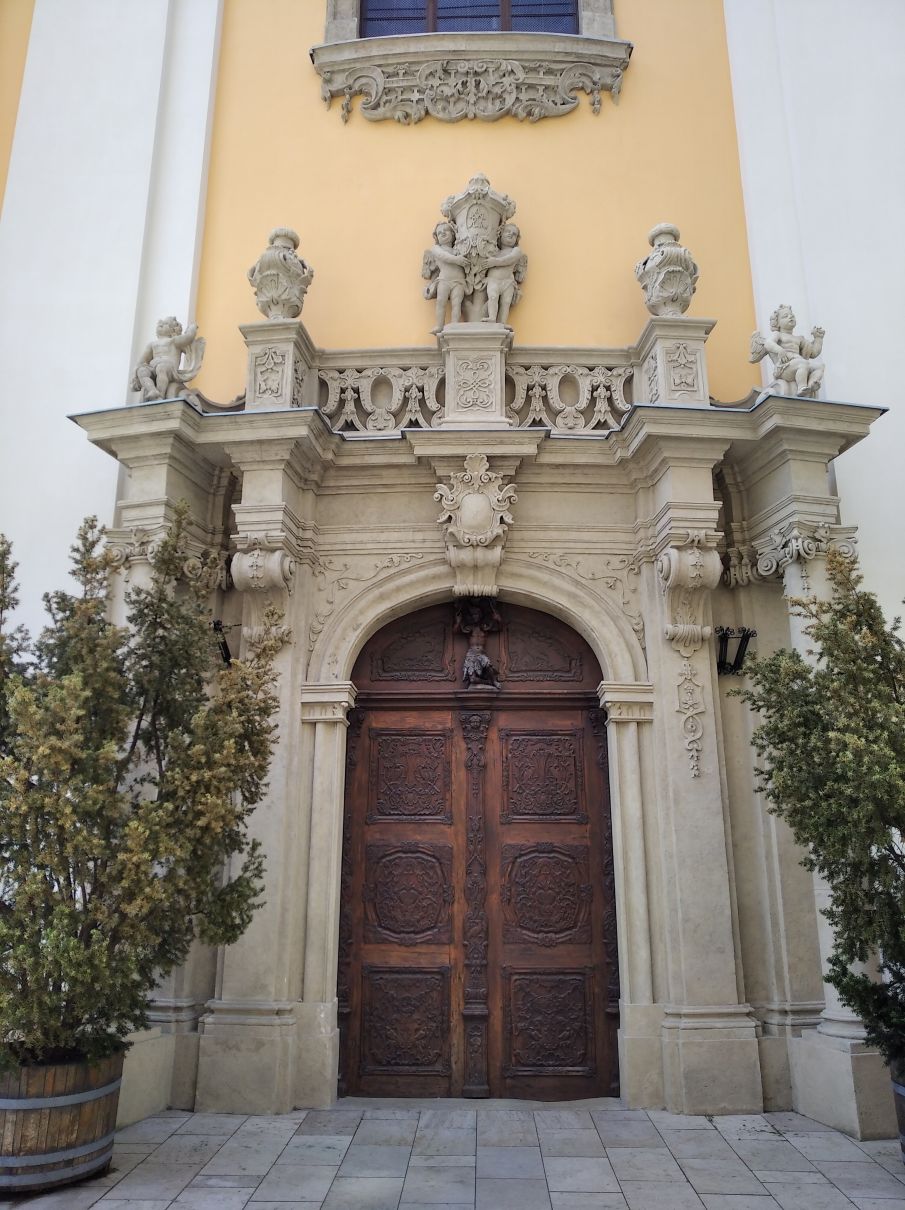
The busy main entrance is also a real baroque creation (Photo: Péter Bodó/pestbuda.hu)
The tower helmets also follow the well-known onion shapes from the Baroque, although they were created more than thirty years later, and were only added to the building in 1776. The interior was also enriched in the early 1770s: the painter Johann Bergl depicted five scenes from the life of Mary on the ceiling of the main nave: the Immaculate Conception, the Annunciation, Mary's visit to Elizabeth, the presentation of Jesus in the church, and above the sanctuary, Mary's Assumption. On the main altar, we can see the birth of Mary in Lipót Antal Conti's very moving sculpture composition, and the side altars are decorated with statues of St. Antal the Hermit and St. Paul the first Hermit, which are works of József Hebenstreit. At the request of the monks, he carved the statue of the order's namesake from real marble, the other figures are only artificial marble - the clients also wanted to pay tribute to their role model. The church decorated in this way was consecrated in 1776 by Ádám Patachich, Archbishop of Kalocsa.
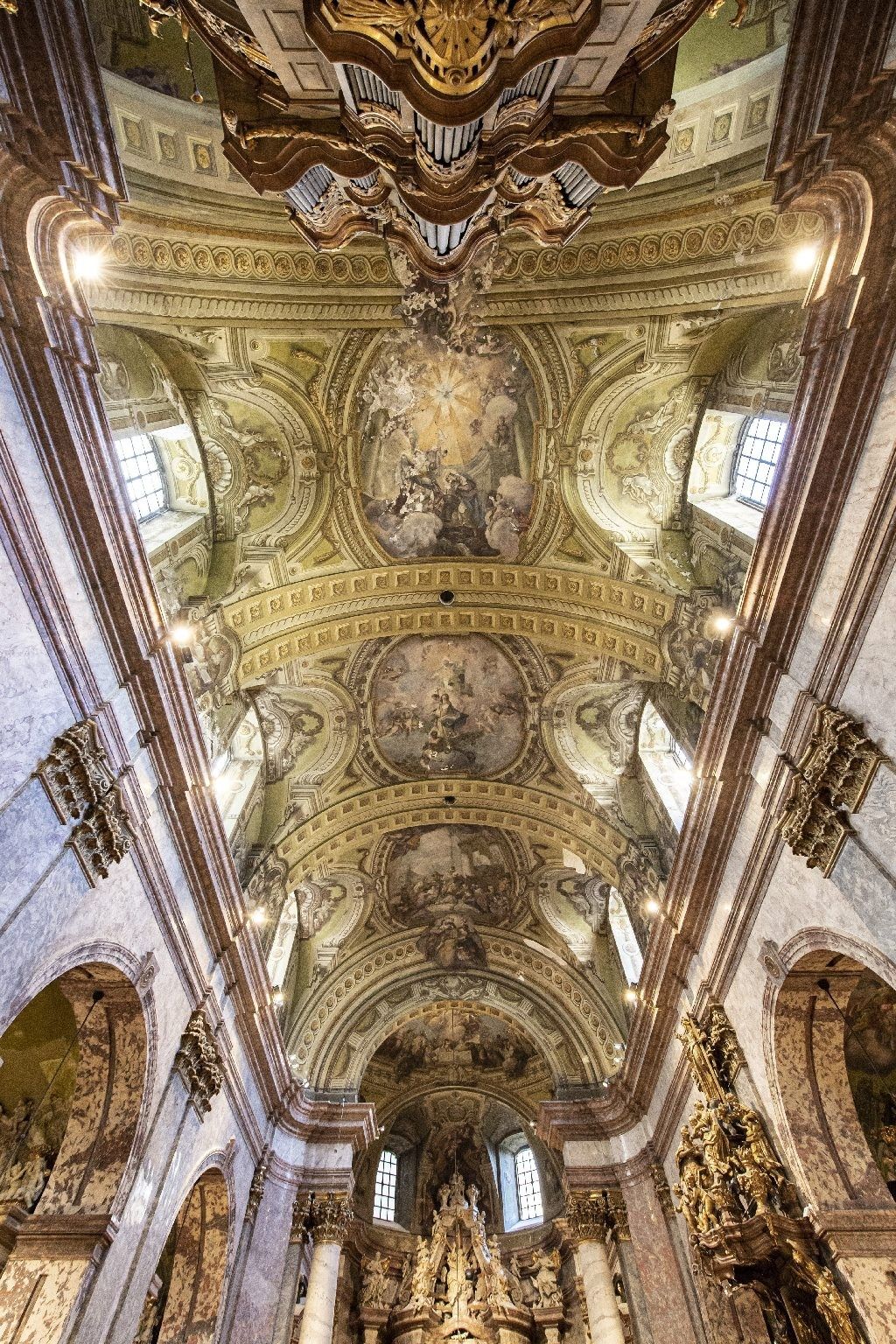
The ceiling paintings depicting scenes from Mary's life are the work of Johann Bergl (Photo: MTI/Zsolt Szigetváry)
Unfortunately, the Paulines could only use the church for ten years, as Joseph II dissolved the order - among others - in 1786. The building was maintained by the Royal Hungarian University, which was moved to Pest two years earlier (1784) and still belongs to it today. Its new owners also paid attention to its beautification, and in 1858, in addition to the necessary restoration, they asked engineer János Achám, head of the National Architectural Directorate, to cover the interior walls with artificial marble. At the same time, the baroque ceiling paintings were also painted with new frescoes that corresponded to the taste of the time. At the beginning of the 20th century, modern technology was also introduced: in 1909, the church received steam heating and electric lighting, and in 1915, an organ manufactured by the Rieger company was set up. The First World War, on the other hand, represented a setback in development, as its bells were requisitioned for military purposes in 1916.

The removal of the bells from the church tower in 1916 (Source: Fortepan/No.: 256277)
At the beginning of the 1920s, the restoration of the church became necessary again, and although the country languished in extremely difficult economic conditions after the Trianon peace decree, the Ministry of Religion and Public Education considered the interests of the church to be of paramount importance and was able to create the necessary financial background. The exterior was first renovated in the fall of 1924 and the spring of 1925, and then, at the request of rector Lajos Ernstzt, the interior was also restored and modernized. The plans were prepared by Jenő Lechner on behalf of the National Committee of Monuments.
During the cleaning of the walls, the original ceiling frescoes created by Johann Bergl were discovered and restored to their original glory. In addition, in order to be more effective, they were lit by lamps hidden on the ledges. The sculptures of the main altar were also made more spectacular using a similar method. Lechner also had the copper candlesticks mounted on the top of the pews removed, which not only worsened the church's spaciousness, but also disturbed the faithful in following the ceremonies. In order to provide adequate lighting, he designed new chandeliers and wall arms in the Empire style, and the perpetual candlestick hung above the altar is an equally sophisticated work of industrial art.
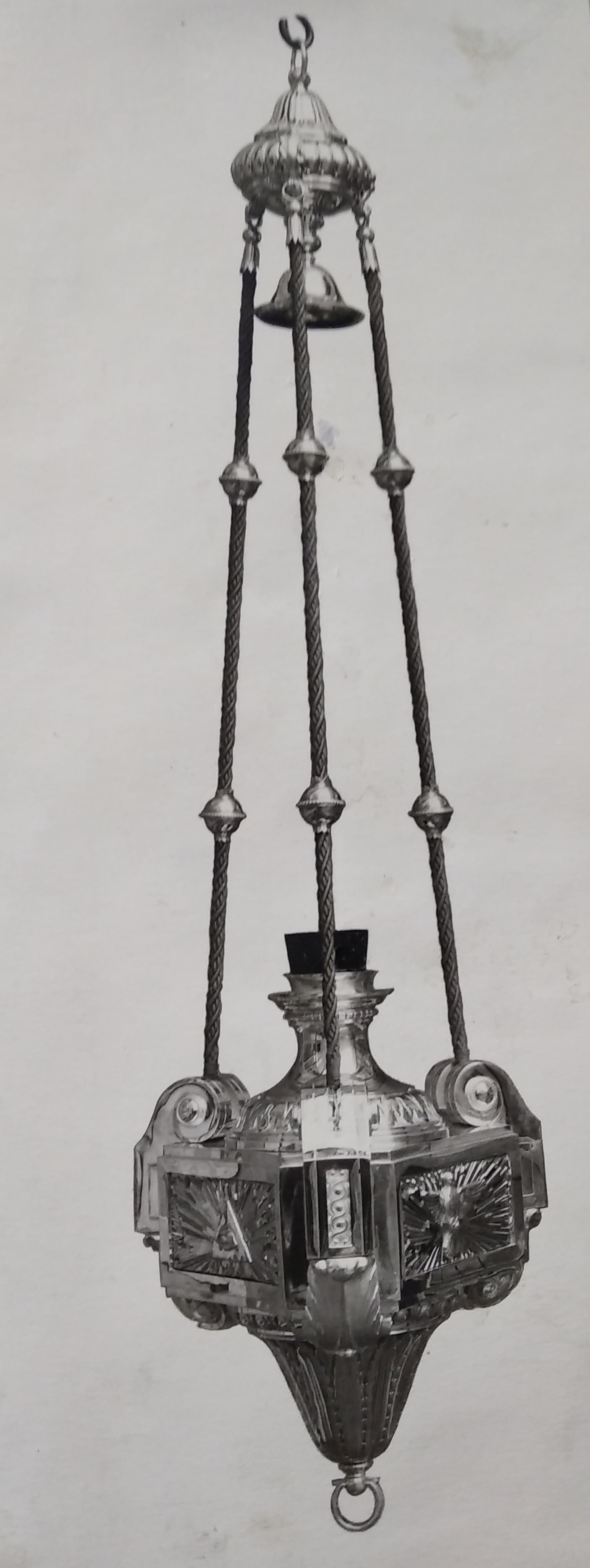
The perpetual candlestick above the altar is on an archival side (Source: Kiscelli Museum of the Budapest History Museum)
Major construction involved the conversion of the crypt under the sanctuary, which could hardly be used before because it was regularly filled with water due to the high water level of the Danube. After the Trianon shock, it was important to strengthen national unity, which was effectively served by cherishing the memory of the famous figures of our history. Minister of Culture Kunó Klebelsberg suggested that a pantheon be arranged in the crypt: the ashes of statesmen, scientists and artists such as Péter Pázmány, Mihály Vörösmarty, Miklós Ybl, Mihály Munkácsy or Ferenc Liszt would have been moved.
In order to achieve this goal, the accessibility of the crypt also had to be improved, because previously only a steep staircase led down from inside the church. According to Lechner's plans, a gate was also opened from the courtyard of the monastery, which included a staircase with a gentler slope. In order to accommodate burials, the side walls of the crypt were divided into niches suitable for placing smaller and larger coffins: 34 large coffins and 84 smaller bone niches were created. The so-called drawer vault covering the crypt was decorated with early Christian paintings by restorer István Gróh, and according to the instructions of Lechner - who, like his uncle Ödön, was also guided by the goal of creating Hungarian art - motifs from the folk ornamentation along the Sajó river were mixed into the decorative painting surrounding them.
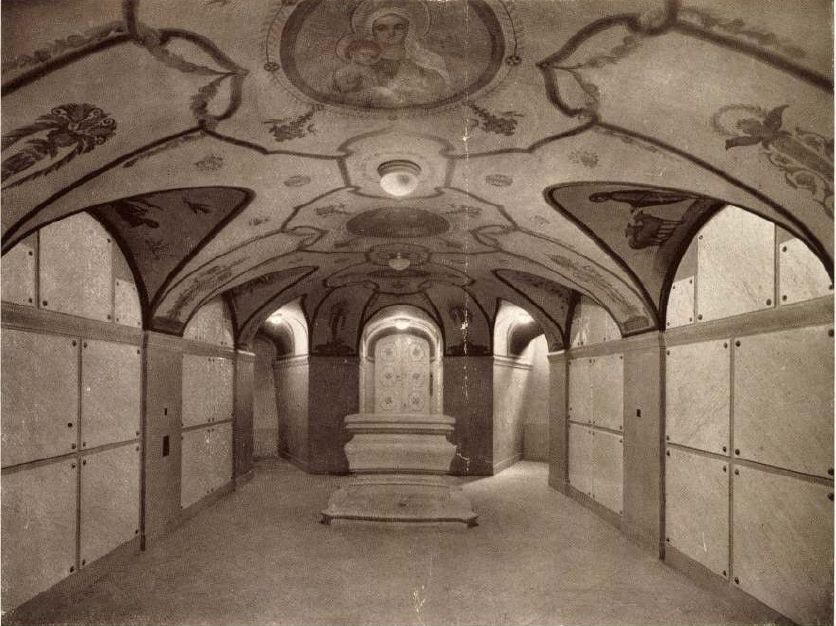
The ceiling of the restored crypt was also decorated with paintings (Source: Tér és Forma, No. 1, 1928)
The complete restoration of the church was finished by the end of 1926. In the spring of the following year, a sad event overshadowed the light of the newly restored interior: Ottokár Prohászka, the bishop of Székesfehérvár, fell ill while preaching in the pulpit, collapsed and soon died. Jenő Lechner made a commemorative plaque, and sculptor György Zala also made a bronze commemorative wreath, the former under the pulpit and the latter on the wall of the side chapel in the fall of 1927. By the way, these two artists - now working together - also created the monument to university heroes erected in 1930 in the narrow area between the University and the church.
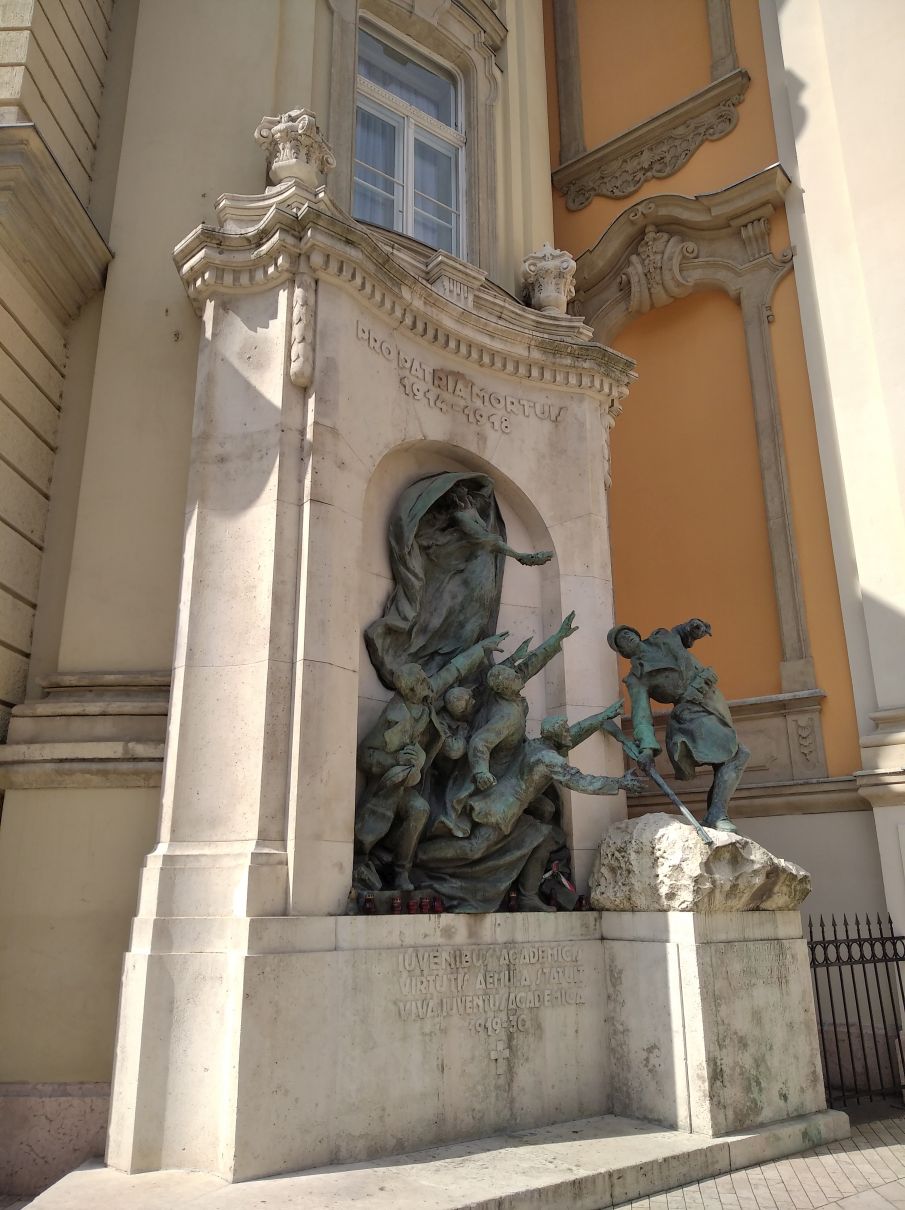
The monument to the University heroes is nowadays at the junction of the ELTE Faculty of Law building and the church (Photo: Péter Bodó/pestbuda.hu)
Klebelsberg's idea, the national pantheon, was ultimately not realized here, and today, unfortunately, the ceiling paintings of the crypt are no longer visible. Fortunately, the church itself still preserves its rich baroque and empire furnishings, which, although formed over centuries, show an organic whole and impress visitors with a great visual experience.
Cover photo: The towers of the University Church (Photo: MTI/Zsolt Szigetváry)

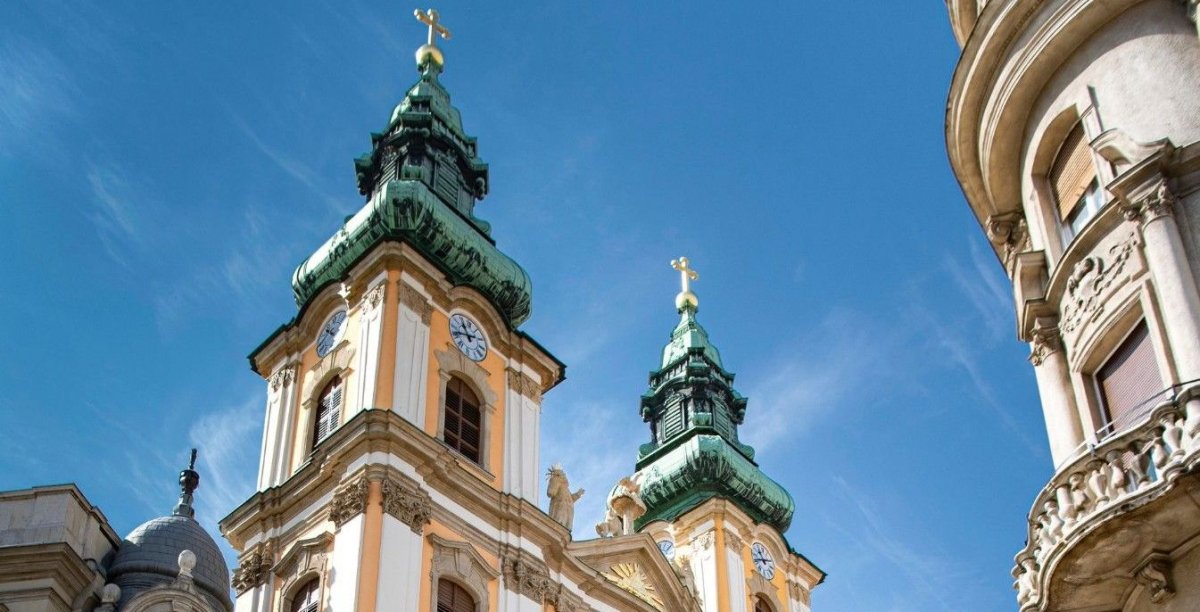


































Hozzászólások
Log in or register to comment!
Login Registration